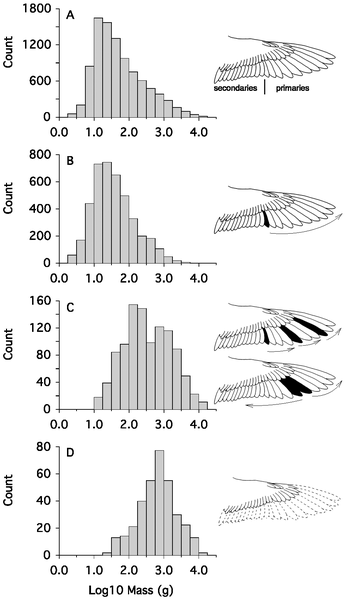|
|
Author Summary - The pace of life varies with body size and
is generally slower among larger organisms. Larger size creates opportunities
but also establishes constraints on timedependent processes. Flying birds
depend on large wing feathers that deteriorate over time and must be replaced
through molting. The lengths of flight feathers increase as the 1/3 power
of body mass, as one expects for a lengthto-volume ratio. However, feather
growth rate increases as only the 1/6 power of body mass, possibly because
a two dimensional feather is produced by a one-dimensional growing region.
The longer time required to grow a longer feather constrains the way in which
birds molt, because partially grown feathers reduce flight efficiency. Small
birds quickly replace their flight feathers, often growing several feathers
at a time in each wing. Larger species either prolong molt over two or more
years, adopt complex patterns of multiple feather replacement to minimize
gaps in the flight surface, or, among species that do not rely on flight for
feeding, simultaneously molt all their flight feathers. We speculate that
the extinct 70-kg raptor, Argentavis magnificens, must have undergone such
a simultaneous molt, living off fat reserves for the duration.
***
Flight feather molt is a time-demanding activity in the avian annual cycle.
Yet, annual or alternate-year replacement of flight feathers is essential,
because physical abrasion and ultraviolet light rapidly degrade even the most
sturdy wing quills after two years of use.

(A) Size distribution for all flying birds (wing shows primary and secondary flight feathers). (B) Size distribution for species with simple molts, characterized by a single wave of primary replacement. (C) Size distribution for species with complex molts that feature either (1) multiple waves of primary replacement proceeding distally through the primaries, or (2) division of the primaries into two molt series with feathers replaced in opposite directions. (D) Size distribution for species that replace their primaries (and secondaries) simultaneously (wing shows lost primaries and secondaries depicted by dotted lines). Most species with simple molts (B) fail to approach 15 kg, the approximate upper size limit of birds set by the power available for flight because such large birds would require too much time to replace their flight feathers. But species with complex (C) and, especially, simultaneous primary replacement (D) reach the upper size limit of birds set by the power required for flight because these modes of primary replacement require less time than simple molts.
***
Funding:Travel to the American Museum was supported by the Burke Museum, the American Museum, and a University of Washington Department of Biology Casey Award. The funders had no role in study design, data collection and analysis, decision to publish, or preparation of the manuscript.
Competing interests statement: The authors declare that no competing interests exist.
Rohwer S, Ricklefs RE, Rohwer VG, Copple MM (2009) Allometry of the Duration of Flight Feather Molt in Birds. PLoS Biol 7(6): e1000132. doi:10.1371/journal.pbio.1000132
Contact: Sally Hubbard
press@plos.org
Public Library of Science